Long Branch: Keys to the City
How old is Long Branch? It goes all the way back to 1668.
According to local folklore, in 1665 five associates from the original Monmouth Patent holders (John Slocum, Eliakim Wardell, Jasper and Peter Parker and George Hulett) first came to Monmouth County (then the British colony of New Jersey) to find suitable land and more religious freedom.
By April 1668 the settlers were seeking to resolve a land acquisition dispute with Native American locals. Starting at dawn at a spot near today’s North Lower Broadway, Slocum engaged in a “two out of three falls” wrestling match with Lenape tribe member Vow-a-Vapon. Under the terms, if Slocum won he could buy all the land that he could “walk off” in one day. If he lost his group had to leave the area with nothing. This pivotal contest took place under a tree on the southwest corner of today’s Ocean Avenue and Broadway, according to the Complete Descriptive Guide to Long Branch, NJ from 1868.
Slocum won a tough match — defeating an opponent who was covered in “goose greased from head to foot.” The agreed payment for the land was “20 shillings per acre.” Slocum got about 375 acres of land; total payment was 4 pounds. Most shared the reward of Slocum’s brief struggle. He got Long Branch, the Parker’s took Rumson/Little Silver, Wardell received Monmouth Beach/Sea Bright, and Hulett disappeared.
The Slocum family would hold much of the land for some 200 years, according to a 1904 Long Branch Daily Record account. In 1683, Slocum was appointed a captain in the colonial militia and later was made a County Ranger. He is also responsible for first developing an old Indian trail (today’s Broadway). Born in Portsmouth, RI in March 1645; he died in February 1702. Slocum Place in the city is named for the family; they also ran the city newspaper for over 25 years.
Myth or fact, the Slocum account has added weight to it — being cited in the 1940 Long Branch city-bio book, Entertaining a Nation. Plus, the city Daily Record — “the people’s paper” in Long Branch — repeats the tale in its July 1951 “Golden Anniversary Edition.”
The first recorded mention of the name Long Branch came in a March 1682 land survey for Abijah Edwards, according to a Long Branch Daily Record story in August 1963, when it was then part of Shrewsbury Twp. In February 1849, Long Branch separated from Shrewsbury Twp. becoming part of Ocean Twp and governed by a three-member township committee.
In April 1867, Long Branch left Ocean Twp. and incorporated as an independent borough — governed by the “Long Branch Police, Sanitary and Improvement Commission.” That was changed to just “Long Branch Commission” about 1900. The first commissioners were: Francis Corlies, Louis B. Brown, Samuel Laird, Jacob Herbert, and Cornelius Van Derveer. Corlies was the first board of commissioners president (or ‘”mayor”) and John Lanning was the first town lawyer. The first election was held in the Arcade Hotel on Lower Broadway. With some adjustments, this five-member city commission set-up would run things in Long Branch for nearly 50 years.
With a new century dawning and city population reaching 10,000 came more governmental change. In May 1904, about 80% of Long Branch voters supported incorporation as a city (under the Coult Charter Act). The city’s first election was in November 1904 and Republicans won — capturing the mayor’s seat and a majority on the new 12-member city council (a 7-5 Republican majority). Just under 3,000 voters cast ballots.
Running as a Republican, the first elected city mayor was C. Asa Francis. He was inaugurated amidst a celebratory parade and ball, with the state’s governor in attendance in December 1904 — just as the “new municipal charter went into effect whereby Long Branch became a city,” according to the Asbury Park Press. Running an “oceanfront improvements” plank, he had defeated Thomas R. Woolley, a Democrat (by 1,446 to 1,353).
In the effort to incorporate as an independent city in early 1904, Long Branch had sought to annex Deal, Loch Arbour, Allenhurst, Eatontown and Monmouth Beach. The NJ state legislature in Trenton rejected these plans but did throw in the Pleasure Bay, Branchport and North End sections. As the Summer of 1907 began, the city was “making titanic efforts to regain its lost prestige,” according to the New York Times.
From 1912 to 1960, a five-member city commission ruled Long Branch (members were paid $2,000/year; the mayor got $2,500/year for most of that time). According to a May 1954 Long Branch Daily Record story celebrating the 50th anniversary of the city, the Long Branch Board of Trade (businesses) and the Long Branch Property Holders Association (homeowners) played major roles in “launching the movement to win a new government for Long Branch.”
“Long Branch is rich in opportunity.”
—Long Branch Daily Record, August 1930
In May 1960, the Long Branch Charter Commission recommended that Long Branch change to a new “council-manager” form of government. Management consultants Booz-Allen had called the city’s commission form of government “archaic” and “a serious impediment to sound administration” as well as “one abandoned by most smaller communities.”
This new city government called for a nine-member city council (with the mayor is selected from its ranks) who hires a administrator to manage city affairs. In November 1960, about 60% of 9,400+ city voters agreed to the new government way — ending commission government in Long Branch forever. In May 1960, among 37 other candidates and 7,200+ voters, Lucy Wilson became the first women elected to a city governing body. Thomas McClintock (high vote-getter and charter chair) became mayor and Samuel Marks, the deputy mayor. The first city manager (its “CEO,” according to the Long Branch Daily Record) was Richard J. Bowen; paid $13,000, he lasted about 18 months.
More civic change came in February 1966, when voters backed by nearly 3-to-1 the Mayor-Council (Plan A) form of municipal government under the Faulkner Act. In May 1966, for the first time a mayor was popularly elected — with 68% of registered voters turning out. Sworn-in July 1966, the first mayor was, Paul Nastasio, and the first city council members were: Henry Cioffi, Samuel Teicher, Elliot Katz, Robert Cornell, and A.V. Ippolito.
Today’s city government operates with a mayor and five-member City Council, whose members are elected at-large in nonpartisan elections to serve four-year terms of office on a concurrent basis.
Long Branch City Hall History & Images — HERE
First Residents: The Lenape —HERE

Winner-Take-All — The wrestling match for “Greater Long Branch” between John Slocum and Vow-a-Vapon took place on lower Broadway, 1668.

The Slocum wrestling match in mural from, 1668. The mosaic was done by West End School students (Beth Anne Duze Woolley Photo).
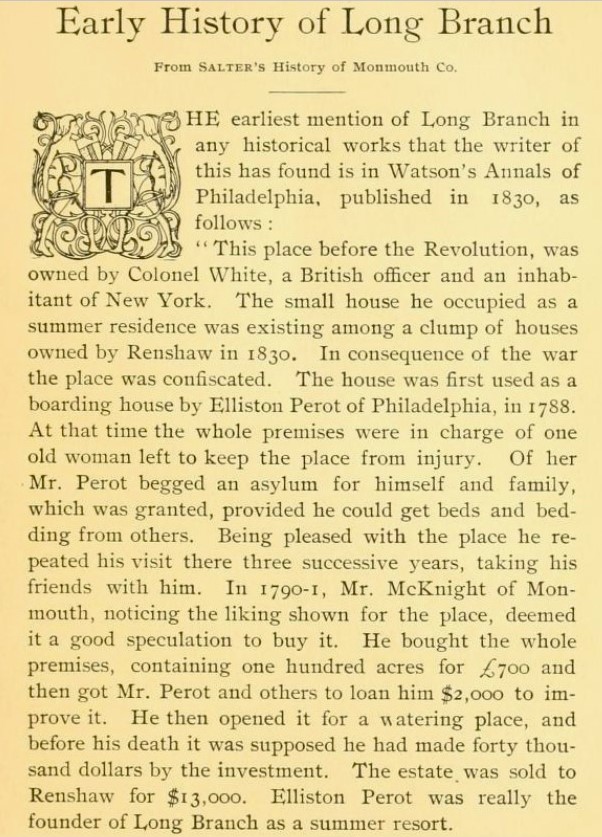
Who is Elliston Perot (1746-1834)? From the History of Asbury Park and Long Branch by George C. Martin (1903) — MORE INFO.
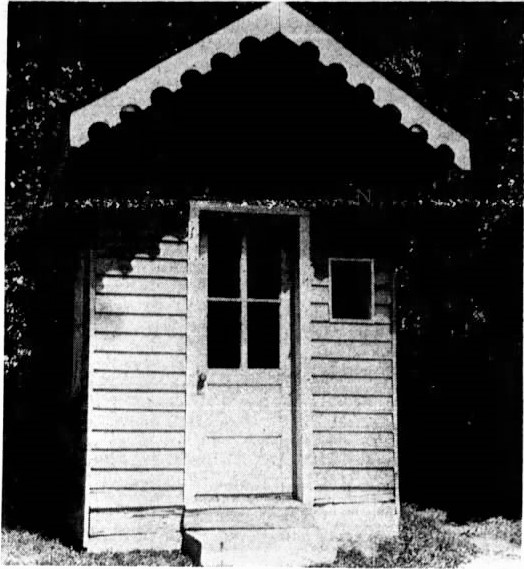
The Divide — “Broadway Turnpike” tollbooth, Long Branch Daily Record, August 1961. By the mid-1830s, Long Branch was largely divided into two sections: Upper Village and Lower Village. To pass from one section to another along Broadway required paying a 2 -cent fare. After much citizen protest, the booth was removed in 1875 when the Long Branch Commission paid $7,000 for the road’s charter.

The Good Book — The City Beyond the Bluff: The Life and Times of Long Branch was authored by Sharon Hazard, 2010 — ORDER. She is a devoted city native and local writer and historian.
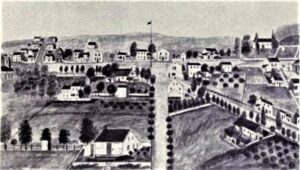
“The Upper Village” … Long Branch, NJ 1850. “Perhaps no town is more steeped in history than is the City of Long Branch.”—Long Branch Daily Record, May 1964.

Walton Sherman political ad, Long Branch Daily Record, May 1944. When he retired after 20 years on the city commission in 1952, no commissioner in Long Branch history had served longer. A LBHS grad, he was treasurer of the family coal company and chairman of the Long Branch Banking Company. After he left the city he served on the Monmouth County Board of Freeholders until his death in October 1964.
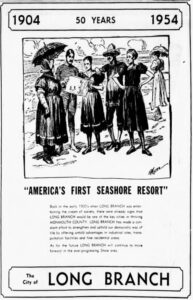
City of Long Branch — 50 Years Incorporated. APP Ad, November 1954. The city would celebrate its “Charter Day” that May with a Broadway parade, beauty contest and Golden Jubilee Show (hosted by Dave Garroway of NBC’s Today).
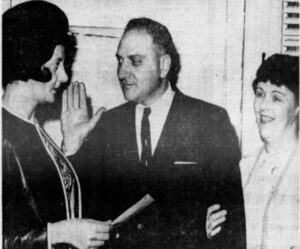
Michael G. Celli an elected member of the Long Branch City Council, LB Daily Record, May 1965. City Clerk Sanita J. Camassa (l) does the swearing in. At right is his wife Dr. Mary Jane Celli, who was elected to the city council herself in May 1994 and still holds the seat today. A 1946 LBHS graduate and owner of Celli Antiques, Mike was also a 30-year US postal worker and the union local president in Long Branch. He died in June 1998. Is there another husband-wife ever elected to the Long Branch City Council?

Gertrude Beman (seated) becomes a city council member, Red Bank Daily Register, November 1969. She was the second women to serve on the Long Branch council. Looking on are City Clerk Sanita Camassa and Council President Wilbert Russell.

New York Giants Hall-of-Fame linebacker Lawrence Taylor with Howard H. “Chubby” Woolley, Jr. during LT’s visit to Long Branch City Hall, 2012. Howard is a Long Branch “Giant” — serving effectively as city Business Administrator from 1994 to 2017. Prior to that he was Executive Director of the Long Branch Sewerage Authority from 1991 to 1994. He was a longtime city Planning Board member and its chairman. A Brown University graduate, he was the youngest person ever elected to the Long Branch City Council in May 1974 at age 26. He lost a narrow race for city mayor in 1978 (by fewer than 300 votes out of nearly 8,000 cast). He was also part owner of the family clothing business, W.H. Woolley’s, a city business landmark that first opened in 1911 on Broadway and operated until 1990.
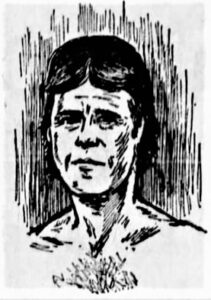
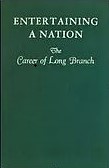
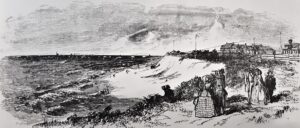



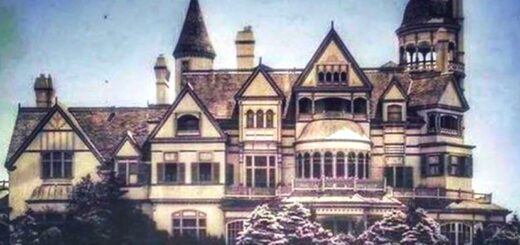
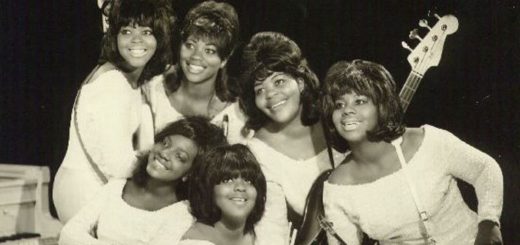
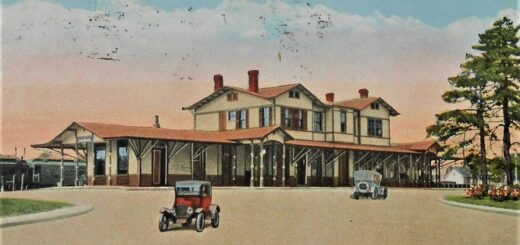


Interesting article. There are names familiar to me, Slocum, Wardell & Van Derveer, in my families ancestry line. I came upon your article when looking for the Slocum family. I have Mary Anna Slocum’s diary (1864), daughter of John & Ann Slocum.